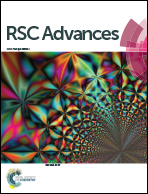Competitive removal of Cd(ii) and Pb(ii) by biochars produced from water hyacinths: performance and mechanism†
Abstract
Three biochars converted from water hyacinth biomass at 300, 450, and 600 °C were used to investigate the adsorption properties of Cd2+ and Pb2+. In addition, the competitive adsorption mechanisms between Cd2+ and Pb2+ were also conducted. Adsorption kinetics and isotherms indicated that the maximum adsorption capacity of Pb2+ was larger than that of Cd2+, and the adsorption process in the mixed solutions of two heavy metals (Cd2+ and Pb2+) was more favorable for Pb2+. Further investigation about the characterization of biochars demonstrated that cation exchange, surface complexation, cation–π interaction and precipitation were the main mechanisms responsible for the heavy metal removal. In this study, competitive adsorption may also be explained by these mechanisms. These results are useful for the application of biochars in selective adsorption and in practical wastewater treatment.


 Please wait while we load your content...
Please wait while we load your content...